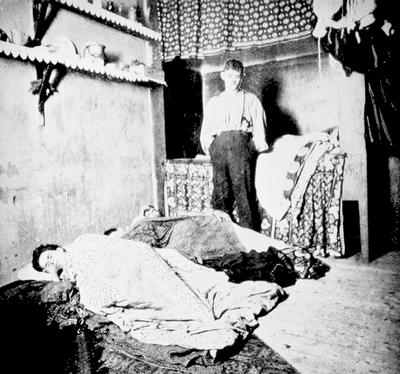
A ticketed house in Bolton Street (later Ardgowan Place) in Kinning Park, c 1892.
The system of ticketing houses was introduced to Glasgow in 1866 to prevent overcrowding in slum areas. All dwellings with three rooms or less and an area of up to 2,000 cubic feet were measured. The authorities calculated that one person needed 300 cubic feet of space and on this basis calculated how many people could sleep in each house. A metal ticket was then attached to each door stating the number of permitted occupants. By the 1880s there were 23,228 ticketed houses in Glasgow sleeping (officially) 75,000 people - roughly one seventh of the city's population.
Sanitary inspectors visited ticketed houses by night, to ensure the rules were followed. This posed photograph illustrates the crowded conditions the inspectors often found. Regulations were often broken and inspectors reported that they found people sleeping in cupboards, under beds or even on rooftops.
Reference: 670.95.170
Reproduced with the permission of Glasgow City Council, Glasgow Museums
Keywords:
housing regulations, lodgers, lodging houses, overcrowding, public health regulations, sanitary inspectors, sleeping, slums, ticketed houses, women
You have 2 images in your photo album.